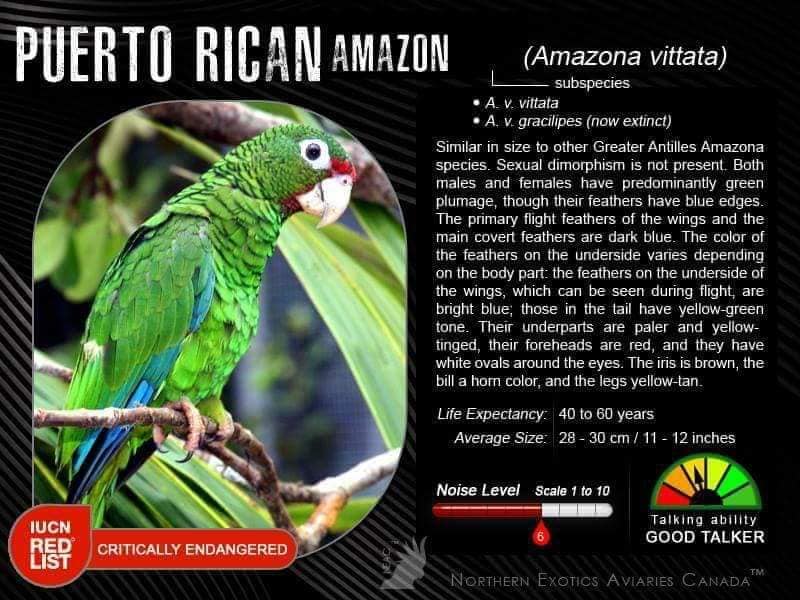Puerto Rican Amazon - Amazona Vittata - Critically Endangered
The Puerto Rican amazon (Amazona Vittata), also known as the Puerto Rican parrot or iguaca, is the only extant parrot endemic to the archipelago of Puerto Rico, and belongs to the Neotropical genus Amazona. Measuring 28–30 cm (11.0–11.8 in), the bird is a predominantly green parrot with a red forehead and white rings around the eyes. Two subspecies have been described, although there are doubts regarding the distinctiveness of the form gracilipes from Culebra Island, extinct since 1912. Its closest relatives are believed to be the Cuban amazon and the Hispaniolan amazon.
The Puerto Rican amazon reaches sexual maturity at between three and four years of age. It reproduces once a year and is a cavity nester. Once the female lays eggs she will remain in the nest and continuously incubate them until hatching. The chicks are fed by both parents and will fledge 60 to 65 days after hatching. This parrot's diet is varied and consists of flowers, fruits, leaves, bark and nectar obtained from the forest canopy.
The species is the only remaining native parrot in Puerto Rico and has been listed as critically endangered by the World Conservation Union since 1994. Once widespread and abundant, the population declined drastically in the 19th and early 20th centuries with the removal of most of its native habitat; the species completely vanished from Vieques and Mona Island, nearby to the main island of Puerto Rico. Conservation efforts commenced in 1968 to save the bird from extinction. In 2012, the total estimated population was 58–80 individuals in the wild and over 300 individuals in captivity.[2]
Taxonomy & Evolution - The Puerto Rican amazon was described by Dutch ornithologist Pieter Boddaert in 1783. It belongs to the large Neotropical genus Amazona, commonly known as amazons; these birds have also been given the generic epithet of "parrot" by the American Ornithologists' Union, hence "Puerto Rican parrot" is an alternative common name in North America. The indigenous Taíno people called it the iguaca, an onomatopoeic name that resembled the parrots' flight call.
There are two recognized subspecies:
Amazona Vittata Vittata - the nominate and only extant subspecies, inhabiting Puerto Rico and formerly nearby Vieques Island and Mona Island.
Amazona Vittata Gracilipes - inhabited Culebra Island and is now extinct. It is unclear whether it was substantially different from the nominate subspecies.
Description - The Puerto Rican amazon measures 28–30 cm (11.0–11.8 in) and weighs 250–300 g (8.8–10.6 oz), or 275 g (9.7 oz) on average. Although small compared to amazons in general, it is similar in size to other Greater Antilles Amazona species. Sexual dimorphism is not present. Both males and females have predominantly green plumage, though their feathers have blue edges. The primary flight feathers of the wings and the main covert feathers are dark blue. The color of the feathers on the underside varies depending on the body part: the feathers on the underside of the wings, which can be seen during flight, are bright blue; those in the tail have yellow-green tone. Their underparts are paler and yellow-tinged, their foreheads are red, and they have white ovals around the eyes. The iris is brown, the bill a horn color, and the legs yellow-tan. Aside from DNA tests, males and females can only be distinguished by behavioral differences during the breeding season. Immature birds have plumage similar to adults.
Population & Distribution - The precise distribution of the Puerto Rican amazon before the arrival of Spanish colonialists is uncertain, because of a lack of contemporary records and then the extermination of the indigenous Taíno people, but the species was apparently widespread and abundant. There is also evidence the species may have inhabited other nearby islands, such as Antigua, Barbuda and the Virgin Islands. Estimates of the parrot's early numbers vary greatly. Some authorities claim that there were once more than a million individuals, while others suggest a more modest population of 100,000. During the first 150 years of Spanish rule the human population was small, and in 1650, when the population of the island was 880 people, the species was still abundant throughout the archipelago. After 1650, human habitation increased exponentially, and by the 18th century the Puerto Rican amazon population started to be affected.
At first, human activity had not posed a significant threat to the Puerto Rican amazon. The Taíno hunted the parrot but without much effect on its population. In the past 200 years, however, many factors have led to a drastic decrease in the birds' numbers: agricultural development, the construction of roads, hydroelectric development, and the adoption of young chicks as pets. Especially during the latter half of the 19th century, most of Puerto Rico's virgin forests, a historical habitat of the species, were cleared for agricultural development, primarily for the production of sugar, cotton, corn and rice. The amazon quickly came to rely on these crops as its main food source and so became seen as a pest; local farmers repelled or hunted the bird if possible. As agriculture expanded, the amazon's habitat disappeared further and its population declined.
By the 1950s, there were only 200 parrots in the wild, and in 1975 the population reached an absolute low of 13 individuals. Numbers then recovered, and in August 1989 there were an estimated minimum of 47 individuals. But on September 18, 1989, Hurricane Hugo struck the northeast coast of Puerto Rico inflicting heavy casualties on the remaining birds. In the aftermath of the hurricane the population was estimated at 23 individuals. In 2004, the wild population was 30–35 individuals, and the long-term trend appears to be stable albeit with some fluctuations. The current range of the species is 16 km2 (6.2 sq mi), 0.2% of what it once was.
Behavior - The Puerto Rican amazon is diurnal, typically beginning its day half an hour after sunrise. It is generally secretive when inside its nest, using its green plumage as camouflage. In contrast, it may be vocal and noisy when outside the nest. Upon taking flight, its color pattern provides some contrast to the forest. The flight mechanism of this species is similar to the one found in other amazons, and involves strokes below the body axis, unlike most birds whose wings flow above their bodies in flight. Amazons can fly moderately fast, reaching a top speed of approximately 30 km/h (19 mph), and are fairly agile when evading predators in mid-air. When in search of food, the parrots group in pairs. Couples and their fledged young display a tendency to stay together. The amazon makes two flight calls, a take-off squawk which consist of a pattern of long squawks, and a loud "bugle", commonly used in flight and which may have several meanings depending on the circumstances when it is used.
Diet - Like almost all amazons, the Puerto Rican amazon is a herbivore. Its diet consists of flowers, fruits, leaves, bark and nectar obtained from the forest's canopy. The species has been recorded to consume more than 60 different materials, although its diet was historically more varied due to its larger range. It normally selects the fruits positioned directly in front of its eyes, picking them one at a time with some rare exceptions. When feeding, it uses a foot to pick up the food. The amazon feeds in a slow, paused manner taking 8–60 seconds to consume separate items.
Breeding - The Puerto Rican amazon usually mates for life, with pairs only changing mates if one bird perishes or abandons the nest. A male may abandon the female if the latter is injured, re-mating with a more "physically perfect" subject. The pairing process is unknown; however, new pairs tend to participate in mutual mating dances characterised by coordinated bows, partial extension of the wings and full tail expansion.
The Puerto Rican amazon is a secondary cavity nester, nesting in tree trunk cavities, both naturally occurring and excavated by other species. It prefers to nest in Palo colorado trees (Cyrilla racemiflora), but uses other trees, including the laurel sabino (Magnolia splendens) and tabonuco (Dacryodes excelsa), to a lesser extent. These trees are mature cavity-forming trees which provide protection against predators and the entry of water. Recently, the species has also nested in artificial wooden boxes designed as part of the recovery plan for the species. Nest height varies from 7–15 m (23–49 ft) above ground. The male usually leads the search for nest sites, although the final decision seems to be taken by the female. Once a site is selected, the pair will spend some time inspecting and cleaning it. No lining material is added to the nest. The Puerto Rican amazon reaches sexual maturity at 4 years of age in the wild and at 3 years in captivity. The species usually reproduces once a year between the months of January and July (the dry season). Copulation between pairs seems to be closely related to food transfers, with this possibly serving as a trigger for intercourse. Amazons have a copulation pattern similar to that found in other parrots throughout the Americas, with the male gripping a perch with one leg while passively placing the other in the female's back. As the time for egg-laying approaches the pair spends more time in the nest, with the male providing food to the female via regurgitation. The female lays 2–4 eggs that she exclusively incubates for a period of 24 to 28 days, while the male will be present in the vicinity of the nest when providing food. Females only leave the nest on rare occasions involving repelling predators or if the male has not brought food in an extended time frame. The chicks are fed by both parents until they leave the nest, usually 60 to 65 days after they hatch. Nonetheless, they remain dependent on their parents and travel with them until the next breeding season.
Like other amazons, the Puerto Rican amazon is gregarious while performing daily activities, but territorial around its nest. The size of the territory around the nest is usually around 50 meters (164 feet). Pairs are extremely cautious near their nest, usually moving in a slow manner when leaving the nest to avoid the attention of predators. Although territorial defense is mostly composed of loud vocalizations there are instances of actual physical combat. Pairs will defend their nest sites against invading couples, sometimes focusing on the location's defense instead of egg-laying. Pairs nesting in areas uninhabited by other parrots will remain mostly silent unless other parrots enter the zone. Some pairs may display moderate territoriality even when not apparently intending to nest, with these tendencies beginning in the latter half of the breeding season. One hypothesis is that this would occur in young pairs that had still not reached full maturity, serving as "practice territoriality".

Psittaciformes, The Parrot Index, a part of Phoenix Feathers © 2016 - 2023
Page last updated: 12/24/23
Phoenix Feathers

